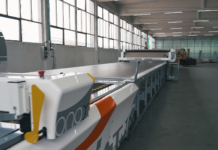 Once again in 2013, strengthening growth on the foreign front was offset by worsening of the Italian market situation. As a result of the contrasting dynamics on the foreign and domestic markets, as just mentioned, the incidence of foreign sales on the 2013 total is expected to increase to 58%.
Once again in 2013, strengthening growth on the foreign front was offset by worsening of the Italian market situation. As a result of the contrasting dynamics on the foreign and domestic markets, as just mentioned, the incidence of foreign sales on the 2013 total is expected to increase to 58%.
Among the subsectors considered here, only leather apparel (supported by quite lively growth abroad) is expected to close 2013 on an upward cline, while women’s knitwear should stabilize at 2012 levels.
Even in light of the decrease in sector imports, the value of production actually carried on in Italy (net revenues deriving from marketing of imported products) remained positive, although by only 0.5%.
A look at the foreign markets shows, as suggested above, confirmation of the positive trend in Italian women’s fashion exports, which accelerated with respect to 2012. On an annual basis, foreign sales should tote up growth by +3.5%, rising to more than 7 billion euro overall. On the other hand, imports are still showing a negative variation, with an estimated drop in 2013 on the order of -3.7%.
Given the picture of trade flows into and out of Italy drawn above, the sector trade surplus should rise by more than 370 million euro, closing in excess of 3.4 billion.
Foreign Trade in the First Ten Months of 2013
According to currently-available ISTAT data (relative to the period from January through October 2013), the dichotomy in foreign trade trends in women’s fashion – already clearly evident in 2012 – continued into 2013. On the exports side of the scale, dynamics were positive; on the imports side, the variations were still in the negative numbers. In more detail, sector imports continued to grow, at a rate of +3% and, therefore, at a faster pace than in the same period of 2012 (+2.5%); imports, on the other hand, were still falling off and in 2013 were down by -4.6% (and thus increasing with respect to the 2012 datum, which as you will recall was -5.8% for the same period).
Analysis of performance by geographic macro-areas shows that in the case of exports – despite the overall dichotomous trend for the last two years – in the first ten months of 2013, even the EU experienced positive dynamics, with a +1.7% increase, although the growth rate in the extra-EU area was still higher (4.3%); in fact, the total Italian sector exports absorbed by this area reached 50.4%.
At the same time, imports were down from all sources, both intra-EU and extra-EU; the flow of goods from the latter area, which as you will remember accounts for 56.6% of total sector imports, ebbed by -6.5%, while imports from EU countries fell off by -2%.
It is worthwhile going beyond the average data by macro area to analysis of the single-country results, which better mirror the trends in the two market areas. Among the EU markets, the variations for France and Germany, respectively the first and third place markets for Made in Italy women’s fashion, were back in the “black”: more modest for France, where growth stopped at +0.7%; faster for Germany, with a +2.9% increase (after the better staying power seen even in 2012). Direct sales to the United Kingdom also increased (+6.6%), while the rate for Spain was still negative (-4.1%).




